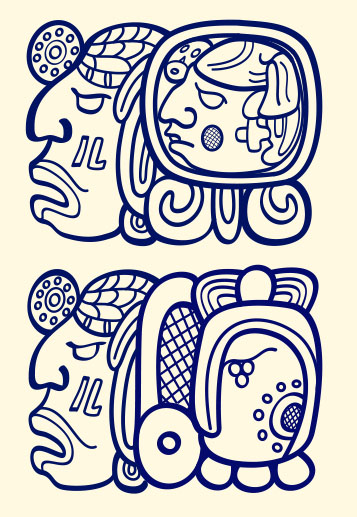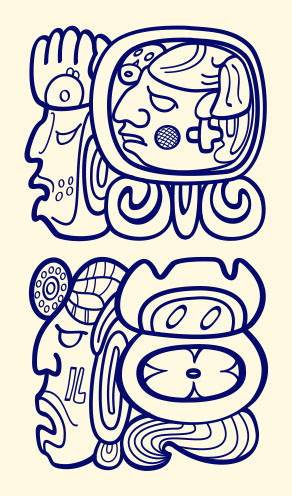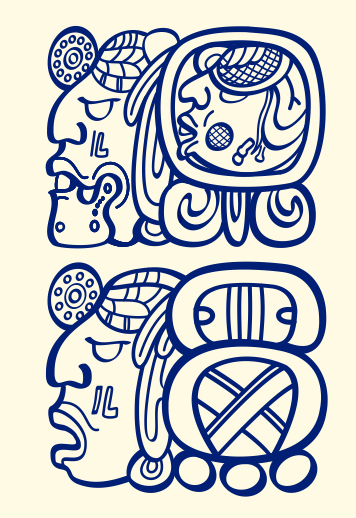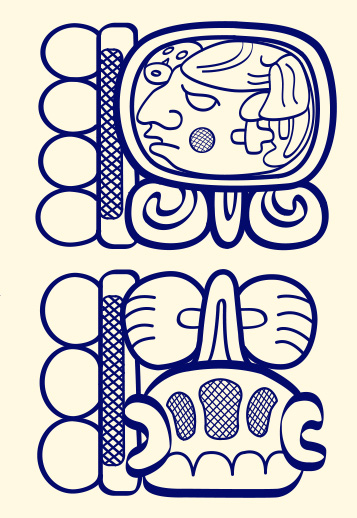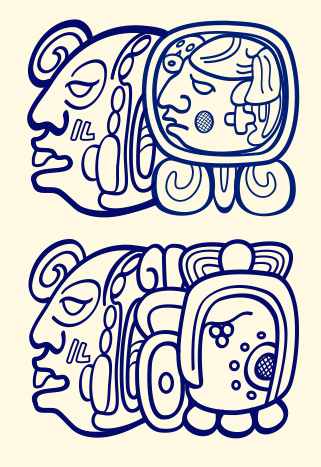
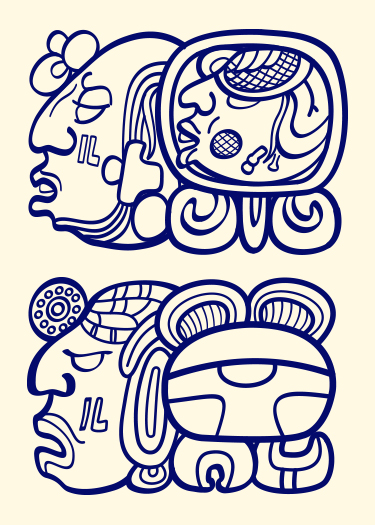
1 Ajaw 3 Sek: Drawing by Jorge Pérez de Lara
[Maya priests hold a ceremony in memorial of the late, well-known Maya spiritual guide and natural medicine expert, Domingo Choc Ché, in Constitution Plaza in Guatemala City, Wednesday, June 10, 2020. (©AP Photo/Moises Castillo, photo used with permission through July 22)]
Nab’e chel iwe,
Nab’e nay puch kixq’ijiloxik
Rumal saqil al,
Saqil k’ajol.
Mawi chisachik i b’i’.
www.mesoweb.com/publications/Christenson/PV-Literal.pdf
“The child who is born in the light, and the son who is begotten in the light shall go out to you first. They shall worship you first. Your name shall not be forgotten.”
~Popol Vuh: The Sacred Book of the Maya. (Christenson 2007:191)
It is with a heavy heart and great sadness that we mourn the tragic loss of Tata Domingo Choc Ché, renowned and respected Q’eqchi’ Maya Elder, Aj Ilonel, specialist in traditional Maya herbal medicine, and Aj Q’ij, spiritual guide. We join with our Maya friends and allies in condemning his senseless and cruel murder and call for justice for all traditional Maya healers, who continue to be persecuted and attacked out of ignorance and misguided religious intolerance.
So much has happened in the last month.
Already suffering through a global pandemic and the resulting economic hardships that have brought the world to its knees, many of us were shocked and awakened to action after the witnessing the murder of George Floyd, following that of Breonna Taylor, and so many other Black lives in the United States at the hands of those meant to protect those very lives. Certainly, these deaths were not the first, as they follow in a longstanding tradition of racism to which many have turned a blind eye, because the current power structure benefits them. But now the world instantly watches all of this on film and we cannot look away. Quarantined in our homes and feeling helpless to act, it seems we reached a tipping point, and we have seen millions of people all over the world marching together, calling for justice and reform, and having difficult conversations about racism and the acknowledgment of White privilege. Perhaps some real, substantive change can come of these painful events.
Then the news arrived last week of the horrific murder of Tata Domingo Choc Ché in Chimay, Guatemala, on June 6th. Once again, we are called to speak out, to demand justice, and to bring awareness to the ongoing persecution of Maya traditional healers and the important ongoing work of decolonization. Again, we have seen an outpouring of grief, anger, and a demand for justice in Guatemala. As allies of Maya people, we need to use our privilege to amplify these voices for the world to help shed much-needed light on this tragedy.
Tata Mingo, as he was known, was a member of the Association of Councils of Spiritual Guides Releb’aal Saq’e’ (ACGERS), and he had extensive knowledge of the medicinal uses of local plants. In collaboration with medical anthropologist Dr. Monica Berger Gonzalez from the University del Valle in Guatemala, Tata Domingo was working on two large transnational research projects with the University of Zurich in Switzerland, and the University College London. He was in the process of scientifically documenting this traditional knowledge, thereby establishing the legitimacy of Maya science and medicine, and he had helped to establish a botanical garden of endangered medicinal species that are disappearing due to deforestation of the Petén. Yet, despite all of this, he was accused of being a “witch-doctor” and burned alive on camera for the world to see.
A group of people in his village of Chimay tortured and killed Tata Domingo in a harrowing and painful way, and the sickening video of the crime circulated rapidly through social media, much like the video of George Floyd. Four people have been arrested and, so far, one of them has openly confessed to the murder on camera, claiming that Tata Domingo was a “witch” who he blamed for the death of his father—apparently based on false rumors that he was practicing witchcraft on his father’s grave. For further details on this tragedy, please see this article from the Prensa Comunitaria:
https://www.prensacomunitaria.org/cual-fue-la-causa-del-crimen-contra-domingo-choc-che-aj-ilonel2/
[Maya priests hold a portrait of well-known Maya spiritual guide and natural medicine expert Domingo Choc Ché during a press conference and ceremony at Constitution Plaza in Guatemala City, Wednesday, June 10, 2020. Police say they arrested four people in connection with the June 7 killing of Choc Ché in the village of Chimay, in the department of Peten, after he was beaten for hours and the next day doused with gasoline and set on fire by people who believed he had been performing witchcraft at a relative’s gravesite. (©AP Photo/Moises Castillo, photo used with permission through July 22)]
Because the alleged perpetrators are also Q’eqchi’ Maya, some have sought to minimize this event as a mere personal vendetta that has nothing to do with racism or religious intolerance. Indeed, further investigation is necessary to ascertain the facts beyond the limited information we have, other than the televised confession of one of the perpetrators, who admitted that he burned Tata Domingo and accused him of being a “witch-doctor” who was responsible for his father’s death.
However, for many others, to minimize this murder as a family squabble misses the larger context of the longstanding discrimination against Maya languages, cultures, and religions, and the increasing attacks on Maya healers in Guatemala based on religious fanaticism and intolerance. Anthropologist Diego Vásquez Monterroso writes:
How can it be racist for a group of Q’eqchi’ to kill a Q’eqchi’? Racism intersects with other forms of contempt for difference (from the dominant group, of course). To accuse someone of being a witch is a death sentence that intersects with another form of hatred: religious extremism. During the Colonial Era, the Maya were first seen within Christianity as minors and later as idolaters. The latter implied that they committed crimes before the Church and the Crown.
https://www.plazapublica.com.gt/content/por-que-triunfa-el-racismo?
Many Maya voices are also speaking out about this, including the K’iche People’s Counsel:
The murder of the spiritual guide Domingo Choc, makes it clear that political and spiritual intolerance remains, and religious fanaticism has deeply damaged the communities.
In current times, the colonial attitudes and behaviors that prevent living the Maya worldview are still in force. When speaking of human rights there is a risk of being assassinated, criminalized and persecuted by groups of people who, manipulated by religious fundamentalism, far from analyzing and questioning indoctrinations, have been submerged and enslaved in ignorance, the result of some religions imposed during the European invasion from 500 years ago to the present day.
Therefore, WE DEMAND that the Public Ministry clarify this reprehensible criminal act. It cannot go unpunished. Identify the masterminds and perpetrators responsible, since several Ancestral Authorities, Spiritual Guides who practice the Maya worldview, are at risk. They are defenders of life and of the territories.
We demand that the Government of Guatemala defend the right to life and freedom of each and all Ajq’ijab’ (spiritual guides), because indigenous peoples have the right to live in harmony with the tangible and intangible elements of Creation and Mother Earth, and there must be necessary measures to guarantee security and freedom.
https://www.prensacomunitaria.org/repudiamos-el-asesinato-de-la-autoridad-ancestral-domingo-choc-che/
In this time of loss and tragedy that is so painful for us to endure, I think it is an important time for all of us to reflect on the ways in which Eurocentrism and systems of colonial domination have inescapably shaped all of us. Only by facing these truths can we ever hope to change our world for the better for all of us.
In our work at MAM, we serve and support Maya communities and teachers who are interested in learning about the ancient script and the calendar in an effort to help fortify and revitalize many different Mayan languages, histories, and cultures. To empower Maya people to be able to learn about their own cultures and histories is an important part of the work of decolonization. For too long, the conversation has been one-sided, and Maya people have been made to feel that their ways of life, their languages, and their cultures are somehow inferior to those of Europe. K’iche’ leader Sebastiana Par Álvarez writes:
Uk’u’x kaj, uk’u’x qanan ulew, kqajach ranima’ ri tat Domingo Choc Ché xe’ q’ab’, xe’ aqan alaq, are ta b’a ri qajaw kuq’aluj pa tew kaqiq’, are tab’a ri qanan ulew kpoq’san uwach rech jun je’lalaj ija’ pa uwi’ ralk’wa’l, pa uwi’ qatinamit.
Heart of Heaven, Heart of Earth, we deliver the being and energy of Tata Domingo Choc Ché. May Qajaw and Mother Earth receive him, embrace him in the clouds, in the air and be a new seed for the good path of the people…
Today it is once again evident that education in Guatemala is decontextualized, and alienated from cultural reality, which is why the indigenous / native population does not even know its own Maya culture and science, thus losing the values of ancestral justice.
We demand from the government of Guatemala prompt justice and fulfillment of the cultural rights, conventions and national and international treaties in favor of indigenous / native peoples.
http://ruda.gt/lideresa-del-pueblo-kiche-manifiesta-indignacion-por-el-asesinato-de-domingo-choc/
Today is 1 Ajaw, Hun Hunahpu, the eponymous name of the Hero Twin from the Popol Vuh who himself was burned in the fires of Xibalbá, only to be reborn as the sun, vanquishing the Lords of Death. Throughout Mesoamerica, the sun itself is seen as a sacred ancestor who generously gives his light and his life so that we all may live. But in saying this, I do not wish to claim that these metaphorical stories are meant to be taken literally. It is perhaps this very religious literalism that is at the root of this tragedy. I am reminded of Carl Jung, and how he warned that we are doomed to literally act out the very myths whose meaning we do not understand.
In our human search for ways in which to render this tragedy with meaning, I am reminded of the ways in which Maya astronomers wove together the movements of the heavens with life on Earth, and the apotheosis of kings. In the Dresden Codex Venus Table, we see that 1 Ajaw is the repeating day commemorating the heliacal rising of Venus as Morning Star after a long cycle of 104 years. Indeed, the very day after Tata Domingo left this world, Venus rose as Morning Star, itself symbolically passing through the fire of the sun and re-emerging at dawn, reborn.
Just yesterday, we reached the summer solstice and a new moon, with a rare annular eclipse on the other side of the world. On this longest day of the year in what seems like the longest year for all of us, we can only hope that the light of this rare new day will bring us much needed illumination.
From multiple ethnographic sources, we know that the day Ajaw/Hunahpu is a day on which to remember the ancestors, and the day on which the patrilineage priest is to visit the family shrine following the loss of a loved one (Christenson 2007: 191). Today, we honor Tata Domingo Choc Ché.
“ ‘We are merely the avengers of your death and your loss, for the affliction and misfortune that were done to you.’ Thus was their counsel when they had defeated all Xibalba.
Then they arose as the central lights. They arose straight into the sky. One of them arose as the sun, and the other as the moon. Thus the womb of the sky was illuminated over the face of the earth, for they came to dwell in the sky.”
~Popol Vuh: The Sacred Book of the Maya. (Christenson 2007:191)
“Xa oj paq’ol i kamik,
I sachik,
K’axk’ol,
Ra’il xb’an chiwe.”
Keje’ k’ut ki pixab’ik
Ri xch’akatajinaqoq ronojel Xib’alb’a.
Ta xe’aq’an k’u loq,
Waral e nik’aj saq.
Ju su k’u
Xe’aq’an chi kaj.
Jun k’u q’ij,
Jun nay pu ik’ chike.
Ta xsaqirik u pam kaj,
U wach ulew.
www.mesoweb.com/publications/Christenson/PV-Literal.pdf
B’antiox, ut Xa wiil acuib’,
Michael Grofe, President
MAM

1 Ajaw 3 Sek: Dibujo de Jorge Pérez de Lara
[Los sacerdotes mayas celebran una ceremonia en memoria del difunto, conocido guía espiritual maya y experto en medicina natural, Domingo Choc Ché, en la Plaza de la Constitución en la Ciudad de Guatemala, el miércoles 10 de junio de 2020. (© AP Photo / Moises Castillo, foto usado con permiso hasta el 22 de julio)]
Nab’e chel iwe,
Nab’e nay puch kixq’ijiloxik
Rumal saqil al,
Saqil k’ajol.
Mawi chisachik i b’i’.
www.mesoweb.com/publications/Christenson/PV-Literal.pdf
“El niño que nace en la luz, y el hijo que es engendrado en la luz, saldrán a ti primero. Se adorarán primero. Su nombre no será olvidado.”
~Popol Vuh: The Sacred Book of the Maya. (Christenson 2007:191)
Con un corazón pesado y una gran tristeza, lamentamos la trágica pérdida de Tata Domingo Choc Ché, el famoso y respetado anciano maya Q’eqchi ‘, Aj Ilonel, especialista en medicina herbaria tradicional maya, y Aj Q’ij, guía espiritual. Nos unimos a nuestros amigos y aliados mayas para condenar su asesinato cruel y sin sentido, y exigimos justicia para todos los curanderos mayas tradicionales, que continúan siendo perseguidos y atacados por ignorancia equivocada e intolerancia religiosa.
Mucho ha sucedido en el último mes.
Ya sufriendo una pandemia global y las dificultades económicas resultantes que han puesto al mundo de rodillas, muchos de nosotros quedamos impactados y despertados a la acción después de presenciar el asesinato de George Floyd, después del de Breonna Taylor y muchas otras vidas negras en los Estados Unidos a manos de aquellos destinados a proteger esas mismas vidas. Ciertamente, estas muertes no fueron las primeras, ya que siguen una larga tradición de racismo a la que muchos han hecho la vista gorda porque la estructura de poder actual los beneficia. Pero ahora el mundo ve instantáneamente todo esto en una película, y no podemos mirar hacia otro lado. En cuarentena en nuestros hogares y sintiéndonos impotentes para actuar, parece que llegamos a un punto de inflexión, y hemos visto a millones de personas en todo el mundo marchando juntas, pidiendo justicia y reforma, y teniendo conversaciones difíciles sobre el racismo y el reconocimiento del privilegio blanco. Quizás algún cambio real y sustantivo pueda venir de estos eventos dolorosos.
Luego llegó la noticia la semana pasada del horrible asesinato de Tata Domingo Choc Ché en Chimay, Guatemala, el 6 de junio. Una vez más, estamos llamados a hablar, a exigir justicia y a crear conciencia sobre la persecución en curso de los curanderos tradicionales mayas y el importante trabajo continuo de descolonización. Nuevamente, hemos visto un torrente de dolor, ira y una demanda de justicia en Guatemala. Como aliados de los mayas, necesitamos usar nuestro privilegio para amplificar estas voces para el mundo y ayudar a arrojar luz sobre esta tragedia que tanto se necesita.
Tata Mingo, como era conocido, era miembro de la Asociación de Consejos de Guías Espirituales Releb’aal Saq’e ‘(ACGERS), y tenía un amplio conocimiento de los usos medicinales de las plantas locales. En colaboración con la antropóloga médica Dra. Mónica Berger González de la Universidad del Valle en Guatemala, Tata Domingo estaba trabajando en dos grandes proyectos de investigación transnacionales con la Universidad de Zúrich en Suiza y el University College London. Estaba en el proceso de documentar científicamente este conocimiento tradicional, estableciendo así la legitimidad de la ciencia y la medicina mayas, y había ayudado a establecer un jardín botánico de especies medicinales en peligro de extinción que están desapareciendo debido a la deforestación del Petén. Sin embargo, a pesar de todo esto, fue acusado de ser uno “brujero” y quemado vivo ante la cámara para que el mundo lo vea.
Un grupo de personas en su pueblo de Chimay torturó y mató a Tata Domingo de una forma desgarradora y dolorosa, y el repugnante video del crimen circuló rápidamente a través de las redes sociales, al igual que el video de George Floyd. Cuatro personas han sido arrestadas, y hasta ahora, una de ellas ha confesado abiertamente el asesinato en cámara, alegando que Tata Domingo fue uno “brujero” a la que culpó por la muerte de su padre, aparentemente basado en rumores falsos de que estaba practicando brujería en la tumba de su padre. Para más detalles sobre esta tragedia, consulte este artículo de Prensa Comunitaria:
https://www.prensacomunitaria.org/cual-fue-la-causa-del-crimen-contra-domingo-choc-che-aj-ilonel2/
[Los sacerdotes mayas sostienen un retrato del conocido guía espiritual maya y experto en medicina natural Domingo Choc Ché durante una conferencia de prensa y ceremonia en la Plaza de la Constitución en la Ciudad de Guatemala, el miércoles 10 de junio de 2020. La policía dice que arrestaron a cuatro personas en relación con el 7 de junio asesinato de Choc Ché en el pueblo de Chimay, en el departamento de Petén, después de que lo golpearon durante horas y al día siguiente lo rociaron con gasolina y le prendieron fuego por personas que creían que el había estado realizando brujería en la tumba de un pariente. (© Foto AP / Moisés Castillo, usado con permiso hasta el 22 de julio)]
Debido a que los presuntos autores también son mayas Q’eqchi’, algunos han tratado de minimizar este evento como una simple venganza personal que no tiene nada que ver con el racismo o la intolerancia religiosa. De hecho, se necesita más investigación para determinar los hechos más allá de la información limitada que tenemos, aparte de la confesión televisada de uno de los autores, quien admitió que quemó a Tata Domingo y lo acusó de ser un “brujero” que fue responsable de La muerte de su padre.
Sin embargo, para muchos otros, para minimizar este asesinato como una disputa familiar se pierde el contexto más amplio de la discriminación de larga data contra las lenguas, culturas y religiones mayas, y los crecientes ataques contra los curanderos mayas en Guatemala basados en fanatismo religioso e intolerancia. El antropólogo Diego Vásquez Monterroso escribe:
¿Cómo puede ser racista que un grupo de q’eqchi’ mate a un q’eqchi’? El racismo se entrecruza con otras formas de desprecio a la diferencia (desde los sujetos dominantes, por supuesto). Acusar de brujo es una sentencia de muerte que se cruza con otra postura de odio: el extremismo religioso. Durante la Colonia, los mayas fueron vistos primero como menores de edad en el cristianismo y después como idólatras. Esto último implicaba que cometían delitos ante la Iglesia y la Corona.
https://www.plazapublica.com.gt/content/por-que-triunfa-el-racismo?
Muchas voces mayas también están hablando sobre esto, incluido el Consejo Popular de K’iche:
El asesinato del guía espiritual Domingo Choc, nos deja claro que la intolerancia política y espiritual se mantiene, el fanatismo religioso ha dañado profundamente a las comunidades.
En tiempos actuales siguen vigentes las actitudes y comportamientos coloniales que impiden vivir la cosmovisión mayab’, al hablar de derechos humanos se corre el riesgo de ser asesinados, criminalizados y perseguidos por grupos de personas quienes manipulados por el fundamentalismo religioso, lejos de analizar y cuestionar los adoctrinamientos, han sido sumergidos y esclavizados en la ignorancia, resultado de algunas religiones impuestas durante la invasión europea desde hace 500 años hasta nuestros días.
Por tanto, EXIGIMOS al Ministerio Público esclarecer este repudiable acto criminal, no puede quedar impune, identificar a los responsables materiales e intelectuales, ya que corren riesgo varias Autoridades Ancestrales, Guías Espirituales que practican la cosmovisión mayab’, que son defensores de la vida y de los territorios.
Exigimos al Gobierno de Guatemala defender el derecho a la vida y la libertad de todas y todos los Ajq’ijab’ (guías espirituales) porque los pueblos originarios tenemos el derecho a vivir en armonía con los elementos tangibles e intangibles cosmogónicos y de la Madre Tierra, que hayan medidas necesarias para garantizar la seguridad y la libertad.
https://www.prensacomunitaria.org/repudiamos-el-asesinato-de-la-autoridad-ancestral-domingo-choc-che/
En este momento de pérdida y tragedia que es tan doloroso para nosotros, creo que es un momento importante para todos nosotros para reflexionar sobre las formas en que el eurocentrismo y los sistemas de dominación colonial nos han moldeado inevitablemente. Solo enfrentando estas verdades podemos esperar cambiar nuestro mundo para mejor para todos nosotros.
En nuestro trabajo en MAM, servimos y apoyamos a las comunidades y maestros mayas que están interesados en aprender sobre la escritura antigua y el calendario, en un esfuerzo por ayudar a fortalecer y revitalizar muchos idiomas, historias y culturas mayas diferentes. Empoderar a los mayas para que puedan aprender sobre sus propias culturas e historias es una parte importante del trabajo de descolonización. Durante demasiado tiempo, la conversación ha sido unilateral, y se ha hecho que los mayas sientan que sus formas de vida, sus idiomas y sus culturas son de alguna manera inferiores a los de Europa. La líder de K’iche, Sebastiana Par Álvarez, escribe:
Uk’u’x kaj, uk’u’x qanan ulew, kqajach ranima’ ri tat Domingo Choc Ché xe’ q’ab’, xe’ aqan alaq, are ta b’a ri qajaw kuq’aluj pa tew kaqiq’, are tab’a ri qanan ulew kpoq’san uwach rech jun je’lalaj ija’ pa uwi’ ralk’wa’l, pa uwi’ qatinamit.
Corazón del cielo, corazón de la tierra entregamos el ser y la energía de tat Domingo Choc Ché, que Qajaw y la madre tierra lo reciba, lo abrace en las nubes, en el aire y sea una nueva semilla para el buen caminar de los pueblos…
Hoy se evidencia una vez más que la educación en Guatemala es descontextualizada, enajenada de la realidad cultural, razón por la cual la población indígena/originaria desconoce hasta su propia cultura y ciencia Mayab’, perdiendo así los valores de la justicia ancestral.
Exigimos al gobierno de Guatemala justicia pronta y cumplimiento de los derechos culturales, convenios y tratados nacionales e internacionales a favor de pueblos indígenas/originarios.
http://ruda.gt/lideresa-del-pueblo-kiche-manifiesta-indignacion-por-el-asesinato-de-domingo-choc/
Hoy es 1 Ajaw, Hun Hunahpu, el nombre homónimo del Héroe Gemelo del Popol Vuh quien fue quemado en los fuegos de Xibalbá, solo para renacer como el sol, venciendo a los Señores de la Muerte. En toda Mesoamérica, el sol mismo es visto como un ancestro sagrado que generosamente da su luz y su vida para que todos podamos vivir. Pero al decir esto, no deseo afirmar que estas historias metafóricas se tomen literalmente. Quizás es este literalismo muy religioso el que está en la raíz de esta tragedia. Recuerdo a Carl Jung y cómo advirtió que estamos condenados a representar literalmente los mitos cuyo significado no entendemos.
En nuestra búsqueda humana de formas de dar sentido a esta tragedia, recuerdo las formas en que los astrónomos mayas tejieron juntos los movimientos de los cielos con la vida en la Tierra y la apoteosis de los reyes. En la Tabla Venus del Códice de Dresde, vemos que 1 Ajaw es el día que se repite conmemorando el surgimiento heliaco de Venus como Estrella de la Mañana después de un largo ciclo de 104 años. De hecho, el mismo día después de que Tata Domingo dejó este mundo, Venus se levantó como Morning Star, pasando simbólicamente por el fuego del sol y resurgiendo al amanecer, renacida.
Ayer, llegamos al solsticio de verano y a una luna nueva, con un raro eclipse anular al otro lado del mundo. En este día más largo del año, en lo que parece ser el año más largo para todos nosotros, solo podemos esperar que la luz de este raro nuevo día nos traiga la iluminación que tanto necesitamos.
De múltiples fuentes etnográficas, sabemos que el día Ajaw / Hunahpu es un día para recordar a los antepasados, y el día en que el sacerdote de patrilinaje debe visitar el santuario familiar después de la pérdida de un ser querido (Christenson 2007: 191) . Hoy honramos a Tata Domingo Choc Ché.
“ ‘Somos simplemente los vengadores de tu muerte y tu pérdida, por el dolor y la desgracia que te han hecho”. También lo fue su consejo cuando derrotaron a todo Xibalba.
Luego se levantaron como las luces centrales. Llegaron directamente al cielo. Uno de ellos surgió como el sol y el otro como la luna. Así, la matriz del cielo se iluminó sobre la faz de la tierra, porque vinieron a morar en el cielo.”
~Popol Vuh: The Sacred Book of the Maya. (Christenson 2007:191)
“Xa oj paq’ol i kamik,
I sachik,
K’axk’ol,
Ra’il xb’an chiwe.”
Keje’ k’ut ki pixab’ik
Ri xch’akatajinaqoq ronojel Xib’alb’a.
Ta xe’aq’an k’u loq,
Waral e nik’aj saq.
Ju su k’u
Xe’aq’an chi kaj.
Jun k’u q’ij,
Jun nay pu ik’ chike.
Ta xsaqirik u pam kaj,
U wach ulew.
www.mesoweb.com/publications/Christenson/PV-Literal.pdf
B’antiox, ut Xa wiil acuib’,
Michael Grofe, Presidente
MAM







